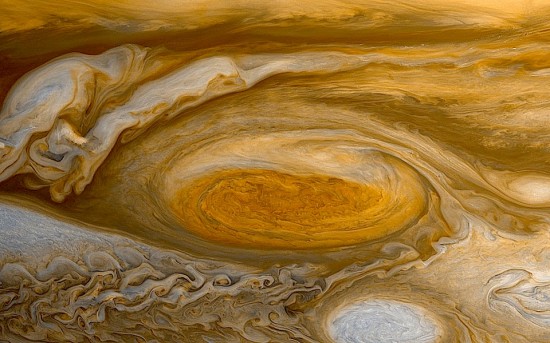May 28, 2014
The size of Jupiter’s red vortex is smaller than ever.
For over 300 years, the Great Red Spot has persisted in Jupiter’s atmosphere—longer than telescopes have existed to see it. It is commonly believed to be a cyclonic storm driven by thermal convection from deep inside Jupiter’s atmosphere. How it was formed and why it has lasted so long remain a mystery, however.
No one is sure why it is red in color. In fact, scientists are not sure why any of the gas giant planets possess unique color schemes. Neptune has a blue tint, Uranus green, Saturn is pale yellow, and Jupiter is a rusty red, overall.
According to a recent press release, the Spot is shrinking. It is now measured to be 16,650 kilometers long, the smallest yet. Measurements over the years indicate that it varies in size. At one point, it was over 39,000 kilometers long and 21,000 kilometers wide.
Conventional investigators contend that the warmer areas in the center of the Spot’s vortex are sufficient to drive its rotation as well as to turn that center a darker red than the rest of the Spot. The red color’s origin—whether from chemical changes in the atmosphere or upwelling of other materials from below—requires further study. Harvard University fluid dynamics researcher; Pedram Hassanzadeh, believes that it is “vertical flow” that maintains the Great Red Spot. Thinking that the red vortex is a storm means that vertical flows circulate hot and cold gas in and out of it, thus preventing it from dissipating.
From an Electric Universe perspective, the Great Red Spot could have a different origin altogether: Jupiter’s turbulent atmosphere might be receiving its energy from an external source.
A previous Picture of the Day described gigantic “plasma tornadoes,” or flux tubes, entering Earth’s magnetosphere from space. They were found by the fleet of THEMIS satellites when they flew through the highly charged structures. The tubes are spinning at more than 1.5 million kilometers per hour and generating over 100,000 amps of electric charge flow.
As mentioned in many past articles, twisted electromagnetic filaments are the characteristic signature of Birkeland currents. Electric fields generate magnetic fields. The fields interact with magnetic fields generated by other flows of charge, forming twisted electromagnetic strands named after the one who originally discovered them, Kristian Birkeland. Birkeland currents “pull” with a force that can be orders of magnitude greater than gravity. Recently, Electric Universe advocate Donald Scott found that they can attract each other with a force that falls off with the square root of the distance, as opposed to gravity’s square of the distance.
Birkeland currents rotate around each other, beginning as many strands spinning around a common center in pairs. At first, there might be 56 filaments that merge into 28, then 14, and so on. As more current flows through the circuit, there are fewer filaments, but each pair becomes more energetic. Where Birkeland currents intersect, z-pinch compression zones occur, glowing brightly as the plasma density increases, releasing abundant thermal (and other) radiation.
Perhaps it is the influx of plasma filaments into Jupiter’s electrically charged environment that creates the Great Red Spot. In an image of Jupiter, several bright points can be seen surrounding the Spot in an arc-shaped array. Below it is another bright arc-shape, indicative of increased infrared radiation emissions.
Rather than vertical flow and convection from below, the Spot is probably rotating because external electromagnetic fields are influencing the atmosphere. The Great Red Spot, as well as other rotating vortices on Jupiter, could be where Birkeland currents impinge on the giant gas planet. If that is the case, any variation in the Birkeland current filaments would cause variation in the size and activity of the vortices on Jupiter.
Stephen Smith
Click here for a Spanish Translation













